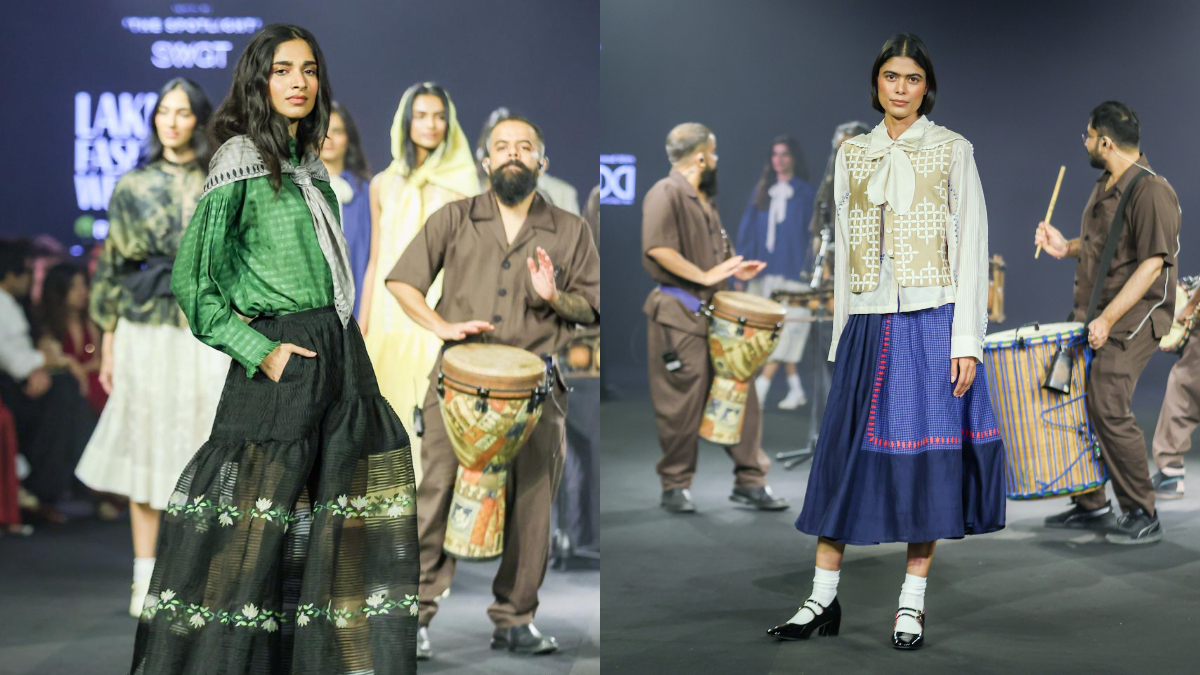Shweta Gupta’s SWGT collection at the recently held Lakmē Fashion Week X FDCI 2025 invites people to slow down and to notice what is often unseen: the rhythm of pintucks, the discipline of pleating, the beauty of form shaped by hand. Crafted in handwoven mulberry silks and soft cottons from West Bengal, and delicate chanderi from Madhya Pradesh, each piece carries the intimacy of touch, structured yet fluid, architectural yet human.
The designer talks about her collection, why it is important to reduce carbon-footprint and more.
Edited excerpts from the interview:
What was the thought that went behind your collection at the LFWXFDCI ?
The collection, ‘Look Closer’, began as a meditation on patience and presence. It’s about slowing down enough to notice what’s often invisible: the quiet rhythm of pin tucks, the discipline behind hand pleating, and the intimacy of a handmade applique. Every garment is shaped by touch, reflecting time, attention, and devotion. I wanted to move away from spectacle and create something deeply human.
What is inclusivity of fashion according to you?
To me, inclusivity lies in design itself: in designing clothes that allow people to feel seen and comfortable in their own skin. It’s not just about size or representation, but about allowing
movement, ease, and individuality within design. My silhouettes honour the natural flow of the body, for everyone. They are fluid and defined at the same time allowing each wearer to find their own version of grace and strength when wearing SWGT.
Your idea on slow fashion and reuse of products into making it completely new?
I feel slow fashion is not a trend; it’s a state of attention. It’s about valuing process, touch, and the human time that goes into creation. When we reuse or reimagine existing pieces, we extend the life of that time and we honour the craft that already exists instead of erasing it. I believe in transforming with respect, not replacing with haste.
Why is it important to be a believer of slow fashion in today’s fast world?
Because speed often strips away meaning and detail. Slow fashion asks us to pause, to reconnect with where things come from and who makes them and what goes into making them.
It restores dignity to labour and reminds us that beauty is not in novelty but in endurance. In a world of instant gratification, patience is somewhat radical. And unless you look closer, you will never be able to appreciate the true beauty.
How important is it to be a conscious consumer?
Conscious consumption is about awareness, not perfection. It’s about buying less but better, asking questions about origin, and understanding the impact of our choices. When consumers
value handwork and time, they shift the system from demand for quantity to respect for quality. And in doing so, they indirectly also provide livelihood to indigenous craft communities, of which there are so many in India.
How machine is inferior to craftsmanship?
Machines can produce, but they cannot feel. Craftsmanship carries emotion and the trace of the human hand that makes each piece imperfectly perfect. That imperfection is what gives
garments soul. Machines can replicate patterns to perfection, but they cannot replicate devotion of a craftsman to his or her craft.
What is your view on the ‘vocal for local’ concept in fashion?
I see it as a celebration of our ecosystems. Although I do see few scalability loopholes that sometimes even I struggle with. But I feel India’s textile heritage is vast and living; supporting local artisans means preserving culture while creating sustainable livelihoods. In my collection Look Closer I have used mulberry silks and cottons from clusters in West Bengal, chanderi from Madhya Pradesh, and hand appliqué is done by women artisans in Uttar Pradesh; each fabric tells its own local story, woven into a global language.
As a designer what should one do to reduce the carbon footprint?
Use what exists: handwoven fabrics, natural dyes, local supply chains, and make fewer, better things. Sustainability begins in thought before it reaches material. Design for longevity and not for the next drop. Pay attention to detail and of course one needs to look closer.
What are your views on pragmatism vs imagination?
I don’t feel they’re opposites; they need each other. Imagination gives design its poetry, while
pragmatism ensures that poetry endures. It’s the balance between art and business. And through my work I seek that balance. SWGT garments move beautifully but live easily, pieces that are emotionally resonant yet practically wearable.
Lachmi Deb Roy is the Entertainment Editor of Firstpost, Network18. She reviews films and series with a gender lens. She is a 'Rotten Tomatoes' certified critic. Her interviews are called 'Not Just Bollywood' because she takes a huge interest in world cinema. She has been the winner of the prestigious Laadli Media and Advertising Award for Gender Sensitivity for two consecutive years, 2020 and 2021. OTT over theatrical releases is her preference unless and until it's a King Khan film. She takes interest in fashion, food and art reviews too.
)